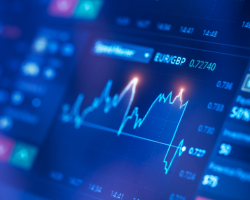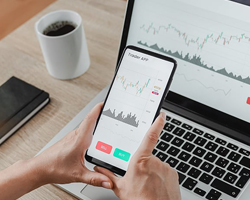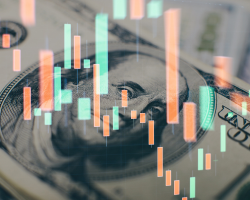How to trade the news

Political and economic news is a powerful source of fluctuation in global financial markets. Even rumors of events such as falling central bank interest rates, lawsuits by governments and large corporations, soaring inflation, and unemployment, or a deteriorating international environment invariably cause market outrage.
The market volatility that has persisted over the past decade has led many investors to question the wisdom of the "buy and hold" strategy. Against this backdrop, trading on the news has become an integral component in the investment plans of many traders. While long-term investors only rarely allow themselves to trade on the news, day traders do so many times during the session. That's why it's safe to say now that learning to trade on the news is an important skill for every trader.
Why trade the news?
News-based trading strategies are popular among traders. Still, we have to warn you that it is far from being the best one for a beginner since it can be very risky. However, if you have some experience and know how to react quickly to unexpected market fluctuations, it can be pretty beneficial for your trading performance.
First off, trading on the news can bring serious returns compared to other strategies since important statistics cause significant impulses and increase volatility. News is the fuel of a trend, boosting it on the way up or down. In addition, the impact of the news is short-term, and an hour after its release, you can close your trade.
Moreover, when working with the news, it is not a must to study technical or fundamental analysis. All necessary information is presented in the economic calendar. The economic calendar indicates the time, the date, and the country or currency to which the news relates. All statistics are ranked by importance, which helps traders make the right decisions.
Trading market news and the different types
Trading on the news takes into account two types of events - unexpected and scheduled. In most cases, the trader works with scheduled ones - these are events that are published according to the schedule. Since the time of publication is known in advance, a trader can be prepared, and by the time news is published, he already knows how it will influence the market and how other players will react.
Unexpected events are natural disasters, military conflicts, and other geopolitical phenomena, which are impossible to predict. But you have to know how to deal with them, or more precisely, you have to be able to react to them right away, by quickly analyzing the price chart. For it is precisely unexpected events that make quotes perform the most spectacular tricks.
Let us have a look at different types of news so you know which one is more suitable for your trading style and capital.
Trading on news that is scheduled
It is quite logical that trading on scheduled news is one of the easiest because traders know in advance how the market behaves before and after the publication. Undoubtedly, there are cases when the market behaves illogically. But it is very rare, and for a trader who knows how to react quickly and hedge his trades against such risks, it is not a big problem. That's why beginners are not recommended to trade on the news, because they don't have the necessary technical and emotional skills to ride the wave of an unexpected NFP report or the Fed decision.

Now we will look closer at scheduled news.
Economic data points
Economic reports and news are one of the most important for forex traders since it provokes huge volatility on the market, especially in major currency pairs.
The five categories of news listed below always cause an increase in volatility:
- NFP (Non-Farm Payroll). The number of people employed in the non-farm payroll.
- CPI - Consumer Price Index.
- FOMC (Federal Open Market Committee) meeting news.
- Trade balance data.
- Retail sales data.
News from these five categories is the most important and always has an impact on the market. You should also pay attention to interest rates and inflation data, news about various geopolitical events, news about any central bank meetings, and data about the GDP of the countries whose currencies you work with.
Company earnings announcements
Earnings season is the period when companies publish quarterly earnings and loss reports. It happens at the end of each fiscal quarter, so the reports come out four times a year - in January, April, July, and October.
Why is this so important? There is always a lot of speculation and forecasting surrounding earnings reports. If the results fall short of expectations or exceed projections, a company's share price enters a brief period of high volatility. That's why traders prepare so carefully for this period because a successful forecast provides an opportunity to make large profits.
Still, it also can be not obvious sometimes. For example, Tesla reported its Q4 earnings - revenue beats analysts estimates by 100K and EPS is in line with the forecast. In this situation the market can react negatively and the price of TSLA stock will go down.
Election announcements
It`s well-known that presidential elections are one of the most expected and influential events in the world of trading and investing. It all makes sense since the market shows lots of fluctuations from the moment the names of the candidates are known and until the inauguration itself.

Let's have a look at the US elections, for instance. Some believe that the S&P 500 index can be used to predict the outcome of the vote. Some are convinced that a Democratic victory has a positive effect on the market, and some are the opposite.
To begin with, it should be noted that there is no clear correlation between the winning party and market dynamics over the periods. In this regard, there remains a friendly parity between Republicans and Democrats. The fact of the change of the ruling party also hardly has any visible influence on the quotes of American shares. In other words, there is no clear pattern that would be evident in the market trends.
However, as for the dynamics of the broad market index S&P 500, certain trends are worth paying attention to.
The S&P 500 index was up 82% (+4.9% on average) six months before the election, 64% (+2.2% and +1.5% respectively) in the three months and the month before, and 86% (+1.9%) in the week before. After the elections, the situation worsens - the chances for the market to fall significantly increase. In the first trading week after the election, the broad market index loses 1% on average.
By and large, only in seven cases out of 22 can we say that market dynamics improved after the election, namely in 1944, 1952, 1960, 1988, 1992, 2004, and 2012. In other words, as a general rule, after an election, the S&P 500 index growth slows, and the decline intensifies.
An interesting point. The US presidential election is on a Tuesday in early November. One would assume that the general seasonal trends that characterize the S&P 500 at any other period should persist in these years. However, this is not the case. In presidential election years, seasonal factors very often don't work.
Trading on news that is unscheduled, or unexpected
This category of news is the most interesting. First, the market reaction to it is extremely wild. Secondly, such news influences assets of all classes, including stocks, indices, bonds and others. Basically, unexpected news can be of two types: black swan and major shifts in supply or demand. Let's have a look at each of them separately.
Black swan events
The concept of the "black swan" was introduced into economics quite recently - in 2007 by the famous trader Nassim Taleb. He used the term to refer to rare events that lead to very significant consequences. He said that people tend to overestimate their ability to predict the future.

For an event to be considered a black swan, it must meet the following criteria:
Unexpected and impossible to predict, because such incidents have never occurred before in history. One of the recent black swans is Britain's exit from the European Union.
Significant consequences. In the case of Brexit, this is a significant depreciation of the British pound, as well as a negative impact on the economy of the European Union.
An opportunity to explain the event post factum. Once it has happened, its preconditions become obvious to all.
Let us look at one of the events that took place recently - the coronavirus pandemic. Of course, nobody expected that, and the world was overwhelmed by panic. As a result, the New York Stock Exchange on March 12, suffered its biggest crash since Black Monday in 1987.
In trading, a black swan usually refers to negative events, although they can also be positive news. As a rule, they occur on Monday, because most significant news happens on weekends. For the trader, a black swan is closing a position on a margin call.
Major shifts in supply or demand
As we all know, the balance of supply and demand is one of the conditions for the regulation of the market economy, which reflects the conformity of the volume of production to the structure of demand. The balance is developed in value terms, and for certain commodities, the estimation in physical terms is additionally used.
The COVID-19 outbreak led to demand shocks in the oil market due to the spread of "social distancing" policies, increasingly reducing the number of daily trips. Demand shocks are historically acute, and recovery from the crisis tends to be robust. However, in addition to the impact of demand, that situation was also characterized by serious changes in supply: in early March 2020, the OPEC+ group failed to reach an agreement, and, instead of the supposed reduction of production by 1.5 million barrels per day, each member of the group was free to increase it as desired. Thus, in the second quarter of 2020, an additional 4 million bpd, or even more, could be "splashed out" on the market in the aggregate. The simultaneous shock change of demand and supply with high probability could lead to a renewal of historical lows for oil prices, while it will be difficult for players to get rid of accumulated stocks. The oversupply may be so severe that even quite stable companies will face significant threats to the business.
How to trade the news
The basic principle of trading the news is to find an event that can shake up the situation in this or that market. For the traders' convenience, the news is sorted and each one is assigned its own rating. The more important a news item is, the higher volatility (price variability of an asset) it can cause. Therefore, the most "explosive" news items are placed at the top of the rating. However, every trader can conduct his analysis and decide which event makes news-based trading strategies the most effective in his or her case.
Each news affects the market in its own way. But it does not give a great advantage to traders who have a good grasp of the details of fundamental analysis. Certainly, knowledge of a country's economy with an approximate idea of what the Central Bank refinancing rate or unemployment rate will be published tomorrow or the day after tomorrow can give a fairly clear picture of price movements. On the other hand, the "hot" news about some major bankruptcy or the resignation of a responsible person can turn the situation in the opposite direction. That's why successful trading on the news depends on the ability to follow the news important to you beforehand, to know exactly when it will be published. Such an approach will allow making decisions in advance by placing pending orders to open positions.
Conventionally, trading the news can be divided into 3 phases:
- The expectation of news publication;
- Information release;
- Traders' reaction.
Let's see what an expectation phase is. For example, the publication of the FOMC meeting report is expected soon. The news will not be published for several days, but experts are already making and publishing their forecasts. These sources are not reliable, but still, give all traders in the world a rough idea of upcoming changes.
The waiting period is actually not at all immersed in a lull. Smart investors understand that after the news is published, the most liquid assets will be bought up in seconds. After all, traders today have at their disposal automatic betting management systems. That's why everyone ready to take a risk uses expert opinions from analytical agencies (Reuters, IDC, Bloomberg, etc.) and opens deals even before the news is published.
In the run-up to the publication of the news. By that time, many investors have already bought assets of interest, which causes a preliminary rise in prices. That is why right after the news release the market reaction can be quite sluggish. To put it simply, the news is out, but the market hardly reacts. What happened? The matter is that many participants have opened positions beforehand, so the news release did not play any role for them.
The news release. Here can be three possible developments:
- the news release coincided with the forecast;
- the situation turned out to be better than forecasted;
- the news turned out to be worse than expected.
What happens if the data coincides with the forecast (let's say the forecast was positive)? In theory, the market is supposed to show growth. But the traders who bought the assets in advance, counting on this news, have already taken profits. Accordingly, there is no potential for further explosive growth in prices.
If the news turns out to be worse than forecasted, the buyers remain in the minority. On the contrary, most traders will want to take profits from bets on the weakening of the asset. As a result, the price may fall dramatically in just a few hours.
If the news is better than forecasted, the situation becomes even more complicated. In theory, prices should move upward, but many factors come into play. For example, periods of growth can be accompanied by a sudden pullback (traders exiting "long" positions take profits, triggering a fall).
News based trading strategies on different asset classes
Each trader has a different approach to trading the news, which is predefined by the instrument itself, the importance of the report, and the forecasted effect on the market. Here are some of the popular news-based trading strategies:
Trading on the news with pending orders
It is better to arrange your trading schedule at least 5-10 minutes before the news releases. For this purpose, it is desirable to keep the economic calendar always beforehand and to mark in it the time of the release of important news.
Several minutes before the publication it is necessary to set two pending orders of different directions - Sell Stop and Buy Stop. The point of installation of the first should be 10 points below the current value of the price, and the point of installation of the second should be 10 points above the value of the price.
After the news is released, the development of events in the financial market can follow one of three scenarios:
- Price will make a sharp jump upward.
- The price will fall.
- There will be no dramatic change and the market will oscillate for a long time.
At working out of the first scenario the pending buy order is activated. In this case, the Sell Stop order should be immediately removed.
If the picture on the chart will develop in the second scenario, there will be an activation of the sell order. Then the Buy Stop order should be immediately removed.
If there are no changes in the market, both orders should be deleted and wait for other news to be released.
Basic news-based trading strategy
From all of the above, we can identify a universal algorithm of actions that is suitable for any economic news trading strategy.

Order of actions:
Analyze the economic calendar, identifying the time of the release of important news. You can find such a calendar at any broker.
Choose a trading asset, associated with the expected news. One of the currencies should be the American dollar. The second currency will depend on the geopolitical affiliation of the published news.
To place pending orders Buy Stop and Sell Stop, having departed from the current price value 5-10 points in both directions. It is necessary to expose the orders 10-15 minutes before the publication.
Set Stop Losses for both orders according to the standard scheme at the level of the nearest extrema.
Wait for the activation of one of the orders, when the volatility of the chart increases. Remove the second order that is not active.
Wait to receive a profit. Add a trailing stop to the trade, or accompany the open position manually. You can close the order after the volatility of the chart begins to decrease. Usually, it happens 15-30 minutes after the publication of the news, when the situation in the market has stabilized.
This algorithm is the easiest and most effective. You do not need to understand the intricacies of technical and fundamental analysis. It is enough to be able to set pending orders and correctly interpret economic calendar data.
Trading the breakout levels
This technique is suitable for hourly and four-hour time frames. The news should be significant and fit into the five categories described above (FOMC, CPI, NFP, etc.). Such news usually creates a new strong trend on the chart.
For the strategy, it is necessary to draw the classic resistance and support levels on the chart. As soon as the price breaches one of them, a trade should be opened in the direction of the breach. Another option is to place pending orders outside each of the levels and wait for one of them to activate.
The histogram of the MACD indicator can be used for finding the market entry point. As soon as its bars change color from green to red and fall below zero level, a sell trade can be opened. If the bars change color from red to green and rise above the central level, it is a signal to open a buy trade.
Stop Loss for trades should be placed several points below or above resistance/support levels, depending on the type of trade. At the same time the higher the market volatility - the more points you can retreat.
Why trade the news with Adrofx
With the different asset classes available for trading, including stocks, cryptocurrencies, indices, currencies and precious metals you can easily make the most out of any news out there. Trading the news with AdroFx lets you get the best trading experience powered by the most convenient and fastest platform MetaTrader 4. With the specially designed different accounts, each trader can find the best one meeting his requirements.
About AdroFx
Established in 2018, AdroFx is known for its high technology and its ability to deliver high-quality brokerage services in more than 200 countries around the world. AdroFx makes every effort to keep its customers satisfied and to meet all the trading needs of any trader. With the five types of trading accounts, we have all it takes to fit any traders` needs and styles. The company provides access to 115+ trading instruments, including currencies, metals, stocks, and cryptocurrencies, which make it possible to make the most out of trading on the financial markets. Considering all of the above, AdroFx is the perfect variant for anyone who doesn't settle for less than the best.









